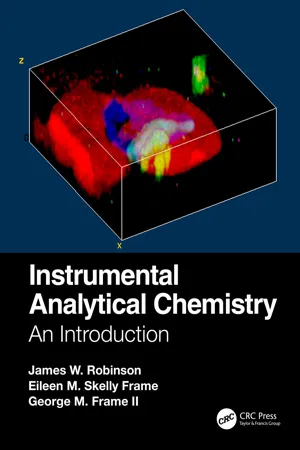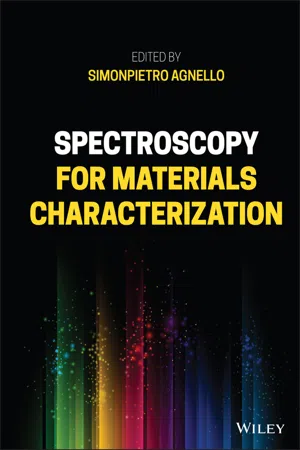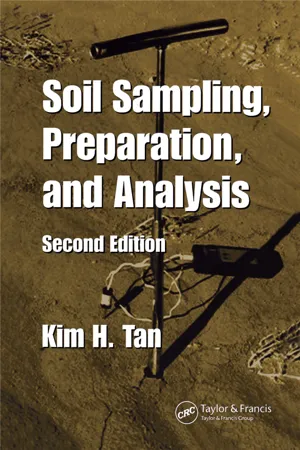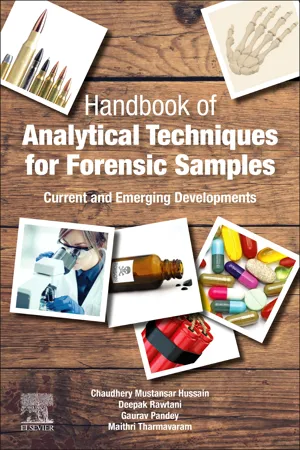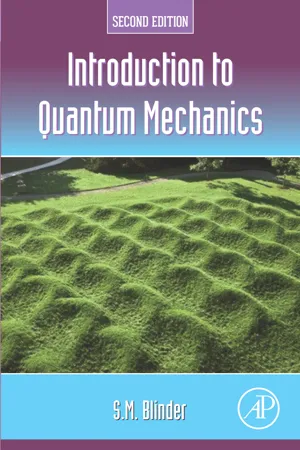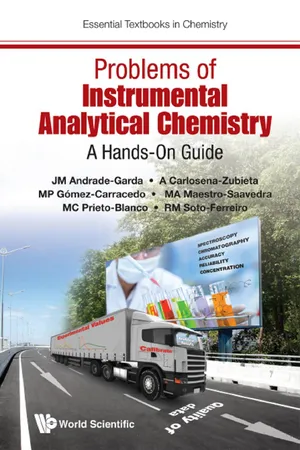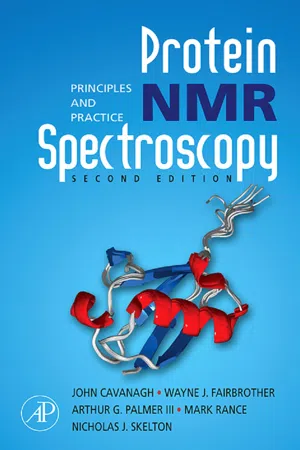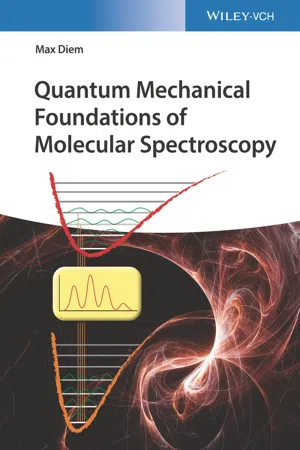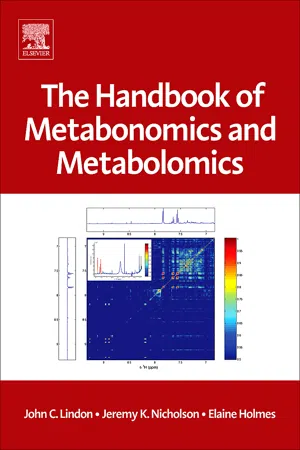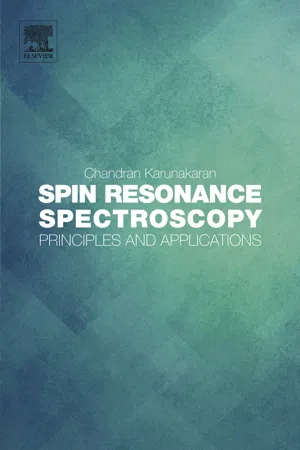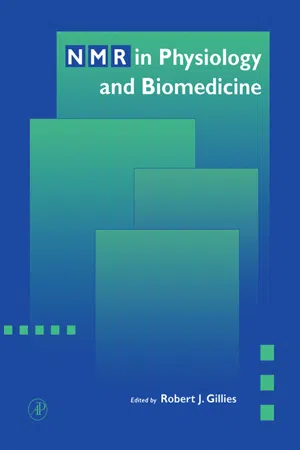Chemistry
Nuclear Magnetic Resonance spectrometer
A Nuclear Magnetic Resonance (NMR) spectrometer is a powerful analytical instrument used to study the structure and dynamics of molecules. It works by subjecting a sample to a strong magnetic field and radiofrequency radiation, causing the nuclei of atoms to resonate at characteristic frequencies. By analyzing the resulting NMR spectra, chemists can determine the connectivity and environment of atoms within a molecule.
Written by Perlego with AI-assistance
Related key terms
Related key terms
1 of 4
Related key terms
1 of 3
12 Key excerpts on "Nuclear Magnetic Resonance spectrometer"
- eBook - ePub
Instrumental Analytical Chemistry
An Introduction
- James W. Robinson, Eileen M. Skelly Frame, George M. Frame II(Authors)
- 2021(Publication Date)
- CRC Press(Publisher)
Magnetic Resonance Spectroscopy 5 DOI: 10.1201/b21879-5 5.1 Nuclear Magnetic Resonance Spectroscopy: Introduction NMR spectroscopy is one of the most powerful techniques available for studying the structure of molecules. The NMR technique has developed very rapidly since the first commercial instrument, a Varian HR-30, was installed in 1952 at the Humble Oil Company in Baytown, Texas. These early instruments with small magnets were useful for studying protons (1 H) in organic compounds, but only neat liquids or solutions with a high concentration of analyte. That has now changed—much more powerful magnets are available. NMR instruments and experimental methods are now available that permit the determination of the 3D structure of proteins as large as 900,000 Da. “Magic angle” NMR instruments are commercially available for studying solids such as polymers, and 13 C, 19 F, 31 P, 29 Si, and other nuclei are measured routinely. NMR imaging techniques under the name magnetic resonance imaging (MRI) are in widespread use in noninvasive diagnosis of cancer and other medical problems. NMR instruments coupled to liquid chromatographs and mass spectrometers for separation and characterization of unknowns are commercially available. Resolution and sensitivity have both increased; detection and identification of ppm concentrations of substances with NMR is easily achieved in modern instruments and detection limits are approaching nanogram levels. NMR detection is being coupled with liquid chromatographic separation in HPLC-NMR instruments for identification of components of complex mixtures in the flowing eluant from the chromatograph, and NMR is now used as a nondestructive detector combined with mass spectrometry and chromatography in HPLC-NMR-MS instruments, an extremely powerful tool for organic compound separation and identification - eBook - ePub
- Simonpietro Agnello, Simonpietro Agnello(Authors)
- 2021(Publication Date)
- Wiley(Publisher)
10 Nuclear Magnetic Resonance Spectroscopy Alberto Spinella1 and Pellegrino Conte2 1 Advanced Technologies Network Center (ATeN Center), University of Palermo, Palermo, Italy 2 Department of Agriculture, Food and Forestry Sciences, University of Palermo, Palermo, Italy10.1 Introduction
Nuclear magnetic resonance (NMR) spectroscopy is a powerful technique used in many fields from basic to applied sciences in order to characterize both molecular and supramolecular structures of organic and inorganic compounds. Among the various spectroscopic techniques, NMR is one of the most versatile due to its ability to unveil three‐dimensionality of molecular systems in each of the three different physical states (liquid, solid, and gas) and regardless of sample crystallinity.Purcell, Torrey, and Pound at Harvard University [1] and Bloch, Hansen, and Packard at Stanford University [2] performed the first NMR experiments in condensed matter independently of each other in 1945. In particular, they obtained NMR signals from protons of paraffin wax and liquid water, respectively. However, since those pioneering days, NMR has become a well‐established spectroscopic technique. In particular, both liquid and solid‐state NMR spectroscopies are largely exploited for molecular structure determination and dynamics in several chemistry fields (e.g. protein chemistry, materials science, cultural heritage, food science, and so on), while NMR imaging is recognized as a very powerful tool in modern medicine in order to monitor biological tissues and living functions.In the following, an overview of the basic principles of NMR spectroscopy and the main topics that may be useful to researches of different areas will be given. A detailed and in‐depth introduction to NMR spectroscopy can be found in several textbooks [3 –5 ].10.2 NMR General Concepts
10.2.1 Nuclear Spin and Magnetic Moment
All elementary particles have an intrinsic property referred to as spin. This property has been introduced to explain the deflection of the elementary particles when they pass through an inhomogeneous magnetic field. In fact, according to the experiment by Stern and Gerlach, an elementary particle, such as an electron, being a moving electric charge, should behave like a small linear magnet when crossing a magnetic field gradient. Therefore, a continuous distribution should be revealed on the surface of a detector. Conversely, the image obtained by elementary particles crossing the magnetic field gradient is an ensemble of discrete points of accumulation. This suggests that all the elementary particles have an intrinsic spin angular momentum which can have only discrete values given by: - eBook - ePub
- Kim H. Tan(Author)
- 2005(Publication Date)
- CRC Press(Publisher)
Chapter 20 Nuclear Magnetic Resonance SpectroscopyNuclear Magnetic Resonance (NMR) spectroscopy is another analytical technique, which is also fairly new. Following its discovery in 1946 and first recorded applications in 1973 (Willard et al., 1974; Pfeffer and Gerasimowicz, 1989), improvements in instrumentation, and advancement in techniques were so rapid that today it is considered a very powerful and important analytical method. Because of the use of radiowaves, analysis by NMR spectroscopy was in the beginning discredited for its low speed and low sensitivity. However, with the development of a Fourier transform NMR spectrometer employing high-field super-conducting electromagnets, the speed and sensitivity of analysis have been improved significantly. Today, this method continues to attract an ever-increasing discipline of sciences, from chemistry, physics, biochemical, medical to agricultural and soil sciences. Its counterpart in medical science, using the same NMR principles, is known under the name MRI, for magnetic resonance imaging. As indicated before, the only difference from NMR is that MRI produces images of the internal organs of the human body, important for diagnosis of pathological disorders.As is the case with SEM, NMR spectroscopy is also a nondestructive or noninvasive method of analysis. However, the high cost of an NMR spectrometer is for many scientists a major drawback, and without sizeable research grant funding at their disposal, only the most affluent laboratories can afford the luxury of possessing one. Nevertheless, the less fortunate can acquire the use of them through personal relations or cooperative research.20.1 Principles of NMR
The basics of NMR discussed in many of the books and articles are far from simple, and if not confusing, often defy the logic of most common scientists. Therefore, the present author has tried ‘translating’ - eBook - ePub
Handbook of Analytical Techniques for Forensic Samples
Current and Emerging Developments
- Deepak Rawtani, Gaurav Pandey, Maithri Tharmavaram, Chaudhery Mustansar Hussain(Authors)
- 2020(Publication Date)
- Elsevier(Publisher)
One such technique that provides direct structural determination without any sample preparation is nuclear magnetic resonance (NMR) spectroscopy. NMR is a technique in that the characteristic electromagnetic signal produced by the nuclei of a molecule under high magnetic fields is detected. NMR can completely determine the structure of a molecule or compound. It is a powerful tool capable of performing both quantitative and qualitative analysis and is therefore employed by industrial as well as the academic institutions across the world. NMR has several advantages that make it suitable for the analysis of forensic evidence. One major advantage is that this technique is capable of observing the molecular dynamics in the liquid or solid state without any sample preparation and keeps the samples preserved even after testing. Apart from this, the instrument does not require any major preparation prior to the sample testing, and it speeds up the data acquisition and analysis of the information obtained from the sample. Most NMR spectrometers are also equipped with a library of molecules that can be used to compare with the sample to be analyzed. Conventionally, NMR has been widely used in forensic chemistry, that deals with the application of chemical principles to identify the structure of a compound. While there are certain advantages to this technique, it is not free of limitations such as low sensitivity and resolution, high cost, and loss of information. However, despite the limitations, NMR is still the most efficient tool to analyze compounds without any damage to the sample - eBook - ePub
- S.M. Blinder(Author)
- 2020(Publication Date)
- Academic Press(Publisher)
Chapter 18: Nuclear magnetic resonance
Abstract
Nuclear magnetic resonance (NMR) involves the interaction of nuclei with magnetic moments with radiofrequency radiation. This can serve as a sensitive probe of the electronic environment of these nuclei. Chemical shifts and spin-spin interactions provide much insight into chemical bonding, to supplement spectroscopic and other measurement techniques. The technology of NMR is now highly developed, using pulse techniques and Fourier transforms. Two-dimensional NMR can be used to study the structure of proteins and other biomolecules. An offshoot of NMR is magnetic resonance imaging (MRI), which has proven to be an invaluable noninvasive medical diagnostic technique.Keywords
Nuclear magnetic resonance (NMR); magnetic nuclei; chemical shift; spin-spin coupling; relaxation processes; pulse techniques; two-dimensional NMR; magnetic resonance imagingNuclear magnetic resonance (NMR) is a versatile and highly-sophisticated spectroscopic technique which has been applied to a growing number of diverse applications in science, technology and medicine. We will consider, for the most part, magnetic resonance involving 1 H and 13 C nuclei.18.1 Magnetic properties of nuclei
In all our previous work, it has been sufficient to treat nuclei as structureless point particles characterized fully by their mass and electric charge. On a more fundamental level, as was discussed in Chap. 1 , nuclei are actually composite particles made of nucleons (protons and neutrons), which are themselves made of quarks. The additional properties of nuclei which will now become relevant are their spin angular momenta and magnetic moments. Recall that electrons possess an intrinsic or spin angular momentum s which can have just two possible projections along an arbitrary direction in space, namely±. Since ħ is the fundamental quantum unit of angular momentum, the electron is classified as a particle of spin one-half. The electron's spin state is described by the quantum numbers1 2ħs =and1 2. A circulating electric charge produces a magnetic moment μ proportional to the angular momentum Jm s= ±1 2 - eBook - ePub
Problems of Instrumental Analytical Chemistry
A Hands-On Guide
- JM Andrade-Garda, A Carlosena-Zubieta;MP Gómez-Carracedo;MA Maestro-Saavedra;MC Prieto-BlancoRM Soto-Ferreiro(Authors)
- 2017(Publication Date)
- WSPC (EUROPE)(Publisher)
CHAPTER 7
NUCLEAR MAGNETIC RESONANCE AND MASS SPECTROMETRIES
Miguel Angel Maestro-Saavedra
OBJECTIVES AND SCOPE
The main objective of this chapter is to present students a concise, basic and practical overview of two powerful techniques for the structural characterization of organic and inorganic chemical structures; namely, nuclear magnetic resonance (NMR) spectrometry and mass spectrometry (MS). Explanations range from essential background to descriptions of key concepts to some practical applications. A selected collection of exercises show how these key concepts are applied and how a structural elucidation from the NMR and MS spectra can be obtained.To explain how to interpret a mass spectrum is anything but simple because there are no fixed rules which can be followed. Therefore, in this chapter, it is attempted to present the very basics of the MS technique and give some general guidances, along with some examples.PART A: NUCLEAR MAGNETIC RESONANCE SPECTROMETRY
1.INTRODUCTION TO NUCLEAR MAGNETIC RESONANCE
Nuclear magnetic resonance (NMR) spectrometry is a fundamental tool for the structural determination of organic and inorganic molecules. It employs low-energy radiation, in the radio frequencies (RF) region, in order to gather information on the structure of alkyl groups and other hydrogen-containing elements. Then, the presence of functional groups in the molecule is deduced.1.1.Basic principles
Many atomic nuclei behave as if they were spinning around themselves (nuclear spin) . When a charged particle (nucleus) moves or rotates, it creates a magnetic field. The orientation of H is random in the space until the nuclei is inserted in an external magnetic field Ho, which causes H to get aligned with H 0 . This can occur in two forms: aligning the magnetic moment H in the direction of the H 0 field (energetically favorable) or otherwise, counterclockwise to H 0 (it requires the input of energy as it is energetically unfavorable). The two possibilities are referred to as the nuclear spin states α and β - eBook - ePub
Protein NMR Spectroscopy
Principles and Practice
- John Cavanagh, Nicholas J. Skelton, Wayne J. Fairbrother, Mark Rance, Arthur G. Palmer III(Authors)
- 2010(Publication Date)
- Academic Press(Publisher)
CHAPTER 1 CLASSICAL NMR SPECTROSCOPYThe explosive growth in the field of nuclear magnetic resonance (NMR) spectroscopy that continues today originated with the development of pulsed Fourier transform NMR spectroscopy by Ernst and Anderson (1 ) and the conception of multidimensional NMR spectroscopy by Jeener (2 , 3 ). Currently, NMR spectroscopy and x-ray crystallography are the only techniques capable of determining the three-dimensional structures of macromolecules at atomic resolution. In addition, NMR spectroscopy is a powerful technique for investigating time-dependent chemical phenomena, including reaction kinetics and intramolecular dynamics. Historically, NMR spectroscopy of biological macromolecules was limited by the low inherent sensitivity of the technique and by the complexity of the resultant NMR spectra. The former limitation has been alleviated partially by the development of more powerful magnets and more sensitive NMR spectrometers and by advances in techniques for sample preparation (both synthetic and biochemical). The latter limitation has been transmuted into a significant advantage by the phenomenal advances in the theoretical and experimental capabilities of NMR spectroscopy (and spectroscopists). The history of these developments has been reviewed by Ernst and by Wüthrich in their 1991 and 2002 Nobel Laureate lectures, respectively (4 , 5 ). In light of subsequent developments, the conclusion of Bloch’s initial report of the observation of nuclear magnetic resonance in water proved prescient: “We have thought of various investigations in which this effect can be used fruitfully” (6 ).1.1 Nuclear Magnetism
Nuclear magnetic resonances in bulk condensed phase were reported for the first time in 1946 by Bloch et al. (6 ) and by Purcell et al. (7 ). Nuclear magnetism and NMR spectroscopy are manifestations of nuclear spin angular momentum. Consequently, the theory of NMR spectroscopy is largely the quantum mechanics of nuclear spin angular momentum, an intrinsically quantum mechanical property that does not have a classical analog. The physical origins of the nuclear spin angular momentum are complex, but have been discussed in review articles (8 , 9 ). The spin angular momentum is characterized by the nuclear spin quantum number, I. Although NMR spectroscopy takes the nuclear spin as a given quantity, certain systematic features can be noted: (i ) nuclei with odd mass numbers have half-integral spin quantum numbers, (ii ) nuclei with an even mass number and an even atomic number have spin quantum numbers equal to zero, and (iii ) nuclei with an even mass number and an odd atomic number have integral spin quantum numbers. Because the NMR phenomenon relies on the existence of nuclear spin, nuclei belonging to category (ii ) are NMR inactive. Nuclei with spin quantum numbers greater than 1/2 also possess electric quadrupole moments arising from nonspherical nuclear charge distributions. The lifetimes of the magnetic states for quadrupolar nuclei in solution normally are much shorter than are the lifetimes for nuclei with I = 1/2. NMR resonance lines for quadrupolar nuclei are correspondingly broad and can be more difficult to study. Relevant properties of nuclei commonly found in biomolecules are summarized in Table 1.1 . For NMR spectroscopy of biomolecules, the most important nuclei with I = 1/2 are 1 H, 13 C, 15 N, 19 F, and 31 P; the most important nucleus with I = 1 is the deuteron (2 - Max Diem(Author)
- 2021(Publication Date)
- Wiley-VCH(Publisher)
8 Nuclear Magnetic Resonance (NMR) Spectroscopy 8.1 General Remarks There are two major spectroscopic techniques that are based on the observation of transitions due to reorientation of spins in a magnetic field when exposed to electromagnetic radiation. These are electron paramagnetic resonance (EPR) and nuclear magnetic resonance (NMR) spectroscopies. In the former, the transitions are between energy states that an unpaired electron spin experiences in an external magnetic field. Some principles of the electron spin were introduced in the previous chapter. NMR spectroscopy, on the other hand, is due to nuclear spin energy states that have not yet been introduced in previous discussions. Whereas EPR requires the presence of a radical molecule or ion (i.e. one with an unpaired electron), NMR is observed for any atom with a nonzero nuclear spin and has been developed mostly for 1 H and 13 C atoms. One can safely say that no spectroscopic method used in chemical and biochemical research has seen as explosive a growth over the past five decades as has NMR spectroscopy that has become a cornerstone for researchers for identification of molecules and to establish molecular structure in solution and in the solid state. A major reason for this growth was the introduction of pulse Fourier transform (FT) methodology in the 1970s (to be discussed in Appendix 4) over continuous excitation that was common before that time. The advent of FT methodology itself was the result of the availability of low cost and dedicated instrument control computers and software to perform the FT rapidly. One other advantage of pulse FT methodology is the ability to program pulse sequences that excite specific aspects of the magnetization of the sample that lead to several new forms of spin interactions that reveal structural details not available in continuous excitation- eBook - ePub
- John C. Lindon, Jeremy K. Nicholson, Elaine Holmes(Authors)
- 2011(Publication Date)
- Elsevier Science(Publisher)
Chapter 3 NMR Spectroscopy Techniques for Application to MetabonomicsAlfred Ross, Goetz Schlotterbeck, Frank Dieterle, Hans Senn Pharma Research, F. Hoffman La-Roche AG, Basel Switzerland3.1. Introduction
Since its discovery in the 1940s, N uclear M agnetic R esonance (NMR) Spectroscopy has become a powerful, interdisciplinary method. A brief historical review would reveal as many as nine Nobel Prize laureates since the time when Isador I. Rabi developed resonance methods for recording the magnetic properties of atomic nuclei and was awarded the Nobel prize in physics (1944). The NMR phenomenon was soon later demonstrated for protons. After years of continuous development, Fourier Transform (FT) NMR entered the scene in the 1960s, followed by the evaluation of non-invasive preclinical and medical imaging in the early 1980s. At the same time, three-dimensional (3D) structure elucidation of proteins at atomic resolution in aqueous environment was developed [1 ]. This breakthrough was made possible also by the availability of superconducting materials and stable and robust electronic equipments.NMR has since been used in an almost unlimited variety of ways in physics, chemistry and biology. For the investigation of biological systems it is convenient to distinguish between three types of applications [2 ]: (1) to study structure and function of macromolecules, (2) to study metabolism, and (3) to obtain in vivo images of anatomical structure and functional (physiological) states.The use of 1 H NMR for metabolic studies was described as early as 1977 when it was shown that 1 H signals could be observed from a range of compounds in a suspension of red blood cells, including lactate, pyruvate, alanine and creatine [3 ]. A great deal of metabolic information can be derived from such metabolic studies and it was soon recognized that 1 H NMR of body fluids has a considerable role to play in areas of pharmacology, toxicology and the investigations of inborn errors of metabolism [4 -6 - eBook - ePub
Spin Resonance Spectroscopy
Principles and applications
- Chandran Karunakaran(Author)
- 2018(Publication Date)
- Elsevier(Publisher)
1.11. Low- and High-Resolution Nuclear Magnetic Resonance
1.11.1. Low-Resolution Nuclear Magnetic Resonance
It refers to low-frequency NMR (below 60 MHz) where spin–spin splitting is not observed. So, it looks much simpler but it cannot distinguish between the individual peaks in the various groups of peaks except its position (chemical shift). However, it provides the following:1. The number of peaks tells the number of different environments for the hydrogen atoms, i.e., the types of protons. 2. The ratio of the areas under the peaks tells the ratio of the number of hydrogen atoms in each of these environments. 3. The chemical shifts give you important information about the sort of environment of the hydrogen atoms, i.e., shielded or deshielded.1.11.2. High-Resolution Nuclear Magnetic Resonance
In high-resolution NMR spectra (frequency above 60 MHz), single peaks in the low-resolution spectrum are split into clusters of peaks [13] .One peak: singlet Two peaks in the cluster: doublet Three peaks in the cluster: triplet Four peaks in the cluster: quartetWe can get exactly the same information from a high-resolution NMR spectrum as from a low-resolution spectrum. But in addition, the amount of spin–spin splitting (J) of the peaks gives valuable electronic, stereochemical, and connectivity information.1.12. Simplification of Complex Nuclear Magnetic Resonance Spectra
The complete NMR spectral analysis of a compound is frequently made difficult, when signals overlap. Consequently, useful information is often buried because of complexity of the spectrum. In such a spectrum, many signals may overlap as is the case of closely related methylene groups in a molecule. In such a situation an intense and broad unresolved signal may appear between δ 1 and 2 - eBook - ePub
- Robert J. Gillies(Author)
- 2013(Publication Date)
- Academic Press(Publisher)
ab initio structure determination and precision and has the merit that it does not require a single crystal; moreover, the structure determined is that found in solution which in many cases corresponds more closely to the natural habitat of the molecule than that found in a crystal. In living systems NMR spectroscopy can monitor the relative and absolute concentrations of metabolites in various anatomical regions, providing a noninvasive measure of physiology and pathology. In medicine it provides the clinician with a noninvasive indicator of disease and continuous assessment of response to therapy.How are these NMR spectra obtained? We have seen that water gives a single sharp NMR response and has a FID which is a simple radiofrequency signal decaying within an exponential envelope of time constant T 2 . If the spectrum consists of two sharp responses close together in frequency, the FID will be the superposition of two radiofrequency signals both within the exponential envelope, the two rf signals exhibiting a characteristic “beat” pattern at their difference frequency. If the spectrum consists of a cluster of several lines of different amplitudes, the FID will be a more complicated rf decay pattern in which all the separate NMR contributions from the different nuclei in the molecules interfere with each other, decaying within an overall envelope characterized by T 2 , which will persist for several seconds. The classic procedure in physics for sorting out all the frequency components in a complicated waveform is Fourier analysis. So we apply a Fourier transform to the acquired FID to yield the NMR spectrum. Indeed it has been shown rather generally by Lowe and Norberg (1957) that the Fourier transform of the NMR free induction decay following an excitation pulse is the NMR spectrum (see alsoErnst et al - eBook - ePub
Understanding Advanced Organic and Analytical Chemistry
The Learner's ApproachRevised Edition
- Kim Seng Chan, Jeanne Tan;;;(Authors)
- 2016(Publication Date)
- WS EDUCATION(Publisher)
CHAPTER 17 Nuclear Magnetic Resonance Spectroscopy 17.1 Introduction Previously, in the chapter on IR spectroscopy, we talked about the three ways to describe the movement of a molecule in space, namely translational, rotational and vibrational motion. The rotational motion about an axis is analogous to the spinning motion of a top. Other than for molecule, such spinning motion (or spin, for short) is also an intrinsic property of particles such as electrons, protons and neutrons. Similar to any linear translation, we can ascribe a magnitude and direction to the spin of a particle. This would mean that we can describe a particle’s spin in terms of how fast it rotates about a particular axis. The direction of the rotation about this axis can be crudely perceived as being clockwise or anti-clockwise. You may have come across the following orbital-as-box diagram, which depicts orbitals as boxes. These are occupied by electrons, with the spins denoted by half-headed arrows as follows: The up and down directions of the arrows denote the two nondegenerate spin states of an electron. Metaphorically, it spins either in a clockwise direction or in an anticlockwise direction. An electron is said to be a spin-1/2 particle. Other spin-1/2 particles include the proton. Both the electron and proton are charged particles that generate a magnetic field when they spin about their own axis. If both the electron and proton spin in the same direction, the magnetic field generated would be in opposite directions. Q: What is a magnetic field? A: A magnetic field is a force field that is generated when a charge particle moves, either in a translational or rotational manner. When a charge particle is stationery, it has a static electric field surrounding it. As it moves along a path, there is a “track” of the changing electric field
Index pages curate the most relevant extracts from our library of academic textbooks. They’ve been created using an in-house natural language model (NLM), each adding context and meaning to key research topics.
Explore more topic indexes
Explore more topic indexes
1 of 6
Explore more topic indexes
1 of 4
